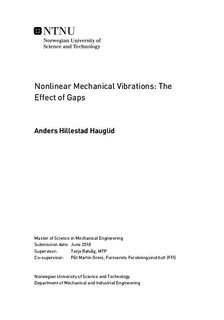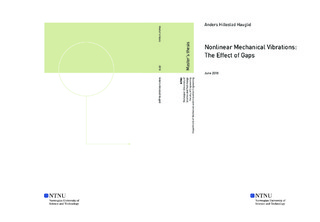| dc.description.abstract | In this report, the vibration properties of nonlinear mechanical joints have been explored. The nonlinearity is due to a clearance gap in the joint, which may arise intentionally in design or through wear and tear. How gap affects the response of the system has been investigated through numerical analysis, experimental tests and finally by means of commercial finite element software. The numerical model is based on solving the nonlinear second-order ordinary differential equation for the system. This is done with Runge-Kutta solvers in MATLAB. The problem is solved in the time domain and the result is transferred to the frequency domain by means of a Fourier transformation. Various relationships have been looked into, especially frequency response functions, Power spectrum density and the Coherence spectrum. The experimental work is based on coupon tests of structures with a bolted connection of different gap distance and different coupon material. The coupon is excited on a shaker table in the lab through harmonic, sine sweep and random vibration input signal. Post-processing is done by means similar to what is done in the numerical work. The work in finite element analysis proposes different formulations of the problem and looks into how gap may be represented efficiently.
The experimental work displays a chaotic behavior. Averaging techniques on data in the frequency domain show that the effective natural frequency, taken as the peak in power spectrum density, is reduced when clearance gaps are introduced to the system. There is, however, no conclusive trend in terms of the relationship between the amount of reduction in $\omega_e$ and gap distance, excitation amplitude or coupon geometry.
The numerical work in MATLAB and FEM display a good correlation with each other, both show the same tendency - $\omega_e$ is reduced by clearance. The work also shows that an increase in gap distance reduces $\omega_e$. The stiffness in the system has also been varied, the results indicate an increase in stiffness reduces the relative natural frequency. More work in the field of topic is recommended for a deeper understanding. | |

